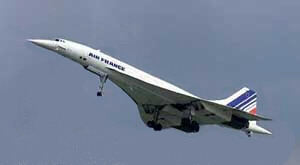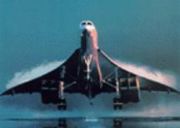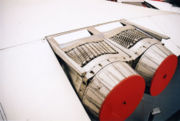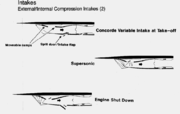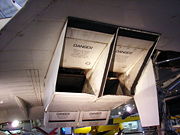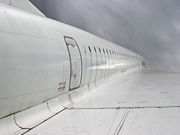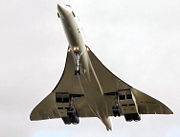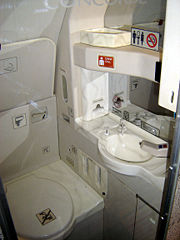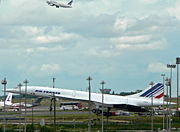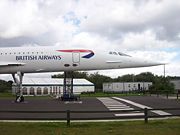Concorde
2008/9 Schools Wikipedia Selection. Related subjects: Air & Sea transport
| Concorde | |
|---|---|
|
An Air France Concorde |
|
| Type | Supersonic airliner |
| Manufacturers | BAC (now BAE Systems) - Sud Aviation (now EADS) |
| Maiden flight | 2 March 1969 |
| Introduction | 21 January 1976 |
| Retired | 26 November 2003 |
| Primary users | British Airways Air France |
| Number built | 20 |
| Unit cost | £23 million in 1977 |
The Aérospatiale-BAC Concorde was a supersonic passenger airliner or supersonic transport (SST). It was a product of an Anglo-French government treaty, combining the manufacturing efforts of Aérospatiale and British Aircraft Corporation. With only 20 aircraft ultimately built, the costly development phase represented a substantial economic loss. Additionally, Air France and British Airways were subsidised by their governments to buy the aircraft. The Concorde was the more successful of the only two supersonic airliners to have ever operated commercially, the Tupolev Tu-144 being the other. The Tu-144 was also the only faster commercial airliner, surpassing the Concorde by 100 mph.
First flown in 1969, piloted by André Turcat, Concorde service commenced in 1976 and continued for 27 years. It flew regular transatlantic flights from London Heathrow (British Airways) and Paris Charles de Gaulle (Air France) to New York JFK and Washington Dulles, flying these routes at record speeds, in under half the time of other airliners. Concorde also set many other records, including the official FAI "Westbound Around The World" and "Eastbound Around the World" world air speed records.
As a result of the type's only crash on 25 July 2000, world economic effects arising from the 9/11 attacks, and other factors, operations ceased on 24 October 2003. The last "retirement" flight occurred on 26 November that year.
Concorde remains an icon of aviation history, and has acquired an unusual nomenclature for an aircraft. In common usage in the United Kingdom, the type is known as "Concorde" rather than " the Concorde" or "a Concorde".
Development
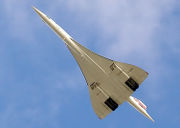
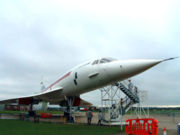

In the late 1950s, the United Kingdom, France, United States and Soviet Union were considering developing supersonic transport. Britain's Bristol Aeroplane Company and France's Sud Aviation were both working on designs, called the Type 233 and Super-Caravelle, respectively. Both were largely funded by their respective governments. The British design was for a thin-winged delta shape (which owed much to work by Dietrich Küchemann) for a transatlantic-ranged aircraft for about 100 people, while the French were intending to build a medium-range aircraft.
The designs were both ready to start prototype construction in the early 1960s, but the cost was so great that the British government made it a requirement that BAC look for international co-operation. Approaches were made to a number of countries, but only France showed real interest. The development project was negotiated as an international treaty between the two countries rather than a commercial agreement between companies and included a clause, originally asked for by Britain, imposing heavy penalties for cancellation. A draft treaty was signed on 28 November 1962. By this time, both companies had been merged into new ones; thus, the Concorde project was between the British Aircraft Corp. and Aerospatiale.
At first the new consortium intended to produce two versions of the aircraft, one long range and one short range. However, prospective customers showed no interest in the short-range version and it was dropped. The consortium secured orders for over 100 of the long-range version from the premier airlines of the day: Pan Am, BOAC and Air France were the launch customers, with six Concordes each. Other airlines in the order book included Panair do Brasil, Continental Airlines, Japan Airlines, Lufthansa, American Airlines, United Airlines, Air Canada, Braniff, Singapore Airlines, Iran Air, Qantas, CAAC, Middle East Airlines and TWA.
The aircraft was initially referred to in Britain as "Concorde," with the French spelling, but was officially changed to "Concord" by Harold Macmillan in response to a perceived slight by Charles de Gaulle. In 1967, at the French roll-out in Toulouse the British Government Minister for Technology, Tony Benn announced that he would change the spelling back to "Concorde." This created a nationalist uproar that died down when Benn stated that the suffixed "e" represented "Excellence, England, Europe and Entente (Cordiale)." In his memoirs, he recounts a tale of a letter from an irate Scotsman claiming: "you talk about 'E' for England, but part of it is made in Scotland." Given Scotland's contribution of providing the nose cone for the aircraft, Benn replied "it was also 'E' for 'Écosse' (the French name for Scotland) — and I might have added 'e' for extravagance and 'e' for escalation as well!"
Construction of two prototypes began in February 1965: 001, built by Aerospatiale at Toulouse, and 002, by BAC at Filton, Bristol. Concorde 001 made its first test flight from Toulouse on 2 March 1969 and first went supersonic on 1 October. The first UK-built Concorde flew from Filton to RAF Fairford on 9 April 1969. As the flight programme progressed, 001 embarked on a sales and demonstration tour on 4 September 1971. Concorde 002 followed suit on 2 June 1972 with a tour of the Middle and Far East. Concorde 002 made the first visit to the United States in 1973, landing at the new Dallas/Fort Worth Regional Airport to mark that airport's opening.
These trips led to orders for over 70 aircraft, but a combination of factors led to a sudden number of order cancellations: the 1973 oil crisis, acute financial difficulties of many airlines, a spectacular Paris Le Bourget air show crash of the competing Soviet Tupolev Tu-144, and environmental concerns such as the sonic boom, takeoff-noise and pollution. Only Air France and British Airways (the successor to BOAC) took up their orders, with the two governments taking a cut of any profits made. In the case of BA, 80% of the profit was kept by the government until 1984, while the cost of buying the aircraft was covered by a state loan.
The United States had cancelled its supersonic transport (SST) programme in 1971. Two designs had been submitted; the Lockheed L-2000, looking like a scaled-up Concorde, lost out to the Boeing 2707, which was intended to be faster, to carry 300 passengers and feature a swing-wing design. Other countries, such as India and Malaysia, ruled out Concorde supersonic overflights due to noise concerns.
Both European airlines flew demonstration and test flights from 1974 onwards. The testing of Concorde set records that have not been surpassed; the prototype, pre-production and first production aircraft undertook 5,335 flight hours. A total of 2,000 test hours were at supersonic speeds. Unit costs were £23 million (US$46 million) in 1977. Development cost overrun was 500% (cost was six times higher than projected).
Design
Concorde was an ogival delta-winged ("OG delta wing") aircraft with four Olympus engines based on those originally developed for the Avro Vulcan strategic bomber. The engines were jointly built by Rolls-Royce and SNECMA. Concorde was the first civil airliner to have an analogue fly-by-wire flight control system. It also employed a trademark droop snoot lowering nose section for visibility on approach.
These and other features permitted Concorde to have an average cruise speed of Mach 2.02 (about 2,140 km/h or 1,330 mph) with a maximum cruise altitude of 18,300 metres (60,000 feet), more than twice the speed of conventional aircraft. The average landing speed was a relatively high 298 km/h (185 mph, 160 knots).
Concorde pioneered a number of technologies:
For high speed and optimisation of flight:
- Double-delta ( ogee/ ogival) shaped wings
- Variable inlet ramps
- Supercruise capability
- Thrust-by-wire engines, predecessor of today's FADEC-controlled engines
- Droop-nose section for improved visibility in landing
For weight-saving and enhanced performance:
- Mach 2.04 (~2,200 km/h - 1350 mph) cruising speed for optimum fuel consumption (supersonic drag minimum, although turbojet engines are more efficient at high speed)
- Mainly aluminium construction for low weight and relatively conventional manufacture (higher speeds would have ruled out aluminium)
- Full-regime autopilot and autothrottle allowing "hands off" control of the aircraft from climbout to landing
- Fully electrically controlled analogue fly-by-wire flight controls systems
- Multifunction flight control surfaces
- High-pressure hydraulic system of 28 MPa (4,000 lbf/in²) for lighter hydraulic systems components
- Fully electrically controlled analogue brake-by-wire system
- Pitch trim by shifting fuel around the fuselage for centre-of-gravity control
- Parts made using 'sculpture milling' from single alloy billet reducing the part-number count, while saving weight and adding strength
- Lack of Auxiliary power unit (Relying on the fact that Concorde will be used for premium services to big airports, where a ground air start cart would be readily available)
- Flush fitting lights
The Concorde programme's primary legacy is in the experience gained in design and manufacture which later became the basis of the Airbus consortium. Snecma Moteurs' involvement with the Concorde programme prepared the company's entrance into civil engine design and manufacturing, opening the way for Snecma to establish CFM International with General Electric and produce the successful CFM International CFM56 series engines.
Although Concorde was a technological marvel when introduced into service in the 1970s, 30 years later its cockpit, cluttered with analogue dials and switches, looked dated. With no competition, there was no commercial pressure to upgrade Concorde with enhanced avionics or passenger comfort, as occurred in other airliners of the same vintage, for example the Boeing 747.
The key partners, BAC (later to become BAE Systems) and Aerospatiale (later to become EADS), were the joint owners of Concorde's type certificate. Responsibility for the Type Certificate transferred to Airbus with formation of Airbus SAS.
Main problems overcome during design
Many issues were overcome whilst researching and developing Concorde.
Movement of centre of pressure
When any aircraft passes the critical mach of that particular airframe, the centre of pressure shifts rearwards. This causes a pitch down force on the aircraft, as the centre of gravity remains where it was. The engineers designed the wings in a specific manner to reduce this shift. However, there was still a shift of about 2 metres. This could have been countered by the use of trim controls, but at such high speeds this would have caused a dramatic increase in the drag on the aircraft. Instead, the distribution of fuel along the aircraft was shifted during acceleration and deceleration to move the centre of gravity, effectively acting as an auxiliary trim control.
Engines
To be economically viable, Concorde needed to be able to fly reasonably long distances, and this required high efficiency. For optimum supersonic flight, turbofan engines were considered, but rejected, as due to their large master cross-section they would cause excessive drag. Turbojets were discovered to be the best choice of engines. The quieter high bypass turbofan engines such as used on Boeing 747s could not be used. The engine chosen was the twin spool Rolls-Royce/Snecma Olympus 593, a version of the Olympus originally developed for the Vulcan bomber, developed into an afterburning supersonic engine for the BAC TSR-2 strike bomber and then adapted for Concorde.
The inlet design for Concorde's engines was critical. All conventional jet engines can intake air at only around Mach 0.5; therefore the air needs to be slowed from the Mach 2.0 airspeed that enters the engine inlet. In particular, Concorde needed to control the shock waves that this reduction in speed generates to avoid damage to the engines. This was done by a pair of intake ramps and an auxiliary flap, whose position was moved during flight to slow the air down. The ramps were at the top of the engine compartment and moved down and the auxiliary flap moved both up and down allowing air to flow in or out. During takeoff, when the engine's air demand was high, the ramps were flat at the top and the auxiliary flap was in, allowing more air to enter the engine. As the aircraft approached Mach 0.7, the flap closed; at Mach 1.3, the ramps came into effect, removing air from the engines which was then used in the pressurisation of the cabin. At Mach 2.0, the ramps had covered half their total possible distance. They also helped reduce the work done by the compressors as they not only compressed the air but also increased the air temperature.
Engine failure causes large problems on conventional subsonic aircraft; not only does the aircraft lose thrust on that side but the engine is a large source of drag, causing the aircraft to yaw and bank in the direction of the failed engine. If this had happened to Concorde at supersonic speeds, it could theoretically have caused a catastrophic failure of the airframe. However, during an engine failure air intake needs are virtually zero, so in Concorde the immediate effects of the engine failure were countered by the opening of the auxiliary flap and the full extension of the ramps, which deflected the air downwards past the engine, gaining lift and streamlining the engine, minimising the drag effects of the failed engine. In tests, Concorde was able to shut down both engines on the same side of the aircraft at Mach 2 without any control problems.
The aircraft used reheat ( afterburners) at take-off and to pass through the transonic regime (i.e. "go supersonic") between Mach 0.95 and Mach 1.7, and were switched-off at all other times. The engines were just capable of reaching Mach 2 without reheat, but it was discovered operationally that it burnt more fuel that way, since the aircraft spent much longer flying in the high- drag transonic regime even though reheat is relatively inefficient.
Due to jet engines being highly inefficient at low speeds, Concorde burned two tonnes of fuel taxiing to the runway. To conserve fuel only the two outer engines were run after landing. The thrust from two engines was sufficient for taxiing to the ramp due to low aircraft weight upon landing at its destination. A Concorde once ran out of fuel taxiing to the terminal after a flight; the pilot was dismissed.
Heating issues
Beside engines, the hottest part of the structure of any supersonic aircraft is the nose. The engineers wanted to use ( duralumin) aluminium throughout the aircraft, due to its familiarity, cost and ease of construction. The highest temperature that aluminium could sustain over the life of the aircraft was 127 °C, which limited the top speed to Mach 2.02.
Concorde went through two cycles of heating and cooling during a flight, first cooling down as it gained altitude, then heating up after going supersonic. The reverse happened when descending and slowing down. This had to be factored into the metallurgical modelling. Owing to the heat generated by compression of the air as Concorde travelled supersonically, the fuselage would extend by as much as 300 mm (almost 1 ft), the most obvious manifestation of this being a gap that opened up on the flight deck between the flight engineer's console and the bulkhead. On all Concordes that had a supersonic retirement flight, the flight engineers placed their hats in this gap before it cooled, where the hats remain to this day. In the Seattle museum's Concorde a protruding cap was cut off by a thief in an apparent attempt to steal it, leaving a part behind. An amnesty led to the severed cap being returned.
In order to keep the cabin cool, Concorde used the fuel as a heatsink for the heat from the air conditioning. The same method also cooled the hydraulics. During supersonic flight the windows in the cockpit became too hot to touch.
Concorde also had restrictions on livery; the majority of the surface had to be white to avoid overheating the aluminium structure due to the supersonic heating effects of Mach 2. In 1996, however, Air France briefly painted F-BTSD in a predominantly-blue livery (with the exception of the wings) as part of a promotional deal with Pepsi Cola. In this paint scheme, Air France were advised to remain at Mach 2 for no more than 20 minutes at a time, but there was no restriction at speeds under Mach 1.7. F-BTSD was chosen for the promotion because the aircraft was not then scheduled to operate any long flights that required extended Mach 2 operations.
Structural issues
Due to the high speeds at which Concorde travelled, large forces were applied to the aircraft structure during banks and turns. This caused twisting and the distortion of the aircraft's structure. This was resolved by the neutralisation of the outboard elevons at high speeds. Only the innermost elevons, which are attached to the strongest area of the wings, are active at high speed.
Additionally, the relatively narrow height of the fuselage meant that the aircraft flexed more, particularly during takeoff, and pilots were able to look back down the cabin and see this occurring, but it was less visible from most of the passengers' viewpoints.
Brakes and undercarriage
Due to a relatively high average takeoff speed of 250 mph (400 km/h), Concorde needed good brakes. Concorde used an anti-lock braking system, which stop the wheels from locking when fully applied, allowing greater deceleration and control during braking, particularly in wet conditions. The brakes were carbon-based and could bring Concorde, weighing up to 185 tons (188 tonnes) and travelling at 190 mph (305 km/h), to a stop from an aborted takeoff within one mile (1600 m). This braking manoeuvre brought the brakes to temperatures of 300 °C to 500 °C, requiring several hours for cooling.
Another issue during the research for Concorde was the undercarriage. It turned out that the undercarriage had to be unusually strong. This was due to the unusual loadings due to the high angle of attack that Concorde needed to take-off due to its delta-wing. This increased the weight and was involved in a major redesign.
Range
Concorde needed to travel between London and New York or Washington nonstop, and to achieve this the designers gave Concorde the greatest range of any supersonic aircraft. This was achieved by a combination of careful development of the engines to make them highly efficient at supersonic speeds, by very careful design of the wing shape to give a good lift to drag ratio, by having a relatively modest payload, a high fuel capacity, and by moving the fuel to trim the aircraft without introducing any additional drag.
Nevertheless, soon after Concorde began flying, a Concorde "B" model was designed with slightly larger fuel capacity and slightly larger wings with leading-edge slats to improve aerodynamic performance at all speeds and featuring more powerful engines with sound deadening and without the fuel-hungry and noisy reheat. This would have given 500 km greater range even with greater payload, and would have opened up new commercial routes. This was cancelled due to poor sales of Concorde.
Increased radiation exposure
The high altitude at which Concorde cruised meant passengers received almost twice the flux of extraterrestrial ionising radiation as those travelling on a conventional long-haul flight. Because of the proportionally reduced flight time, however, the overall equivalent dose was less than a conventional flight over the same distance. Unusual solar activity led to an increase in incident radiation, so the flight deck had a radiometer and an instrument to measure the rate of decrease of radiation. If the level was too high, Concorde descended to below 47,000 ft (14,000 m). The rate of decrease indicator indicated whether the aircraft needed to descend further, decreasing the amount of time the aircraft was at an unsafe altitude.
Cabin pressurisation
Airliner cabins are usually pressurised to 6-8,000 ft (1,800-2,400 m) elevation while the aircraft flies much higher. Concorde's pressurisation was set to a lower altitude than most other commercial jets. Some passengers can have difficulty even with that pressurisation. A sudden reduction in cabin pressure is hazardous to all passengers and crew. Concorde's maximum cruising altitude was 60,000 ft (18,000 m) (though the typical altitude reached between London and New York was about 56,000 ft (17,000 m)); subsonic airliners typically cruise below 40,000 ft (12,000 m). Above 50,000 ft (15,000 m), the lack of oxygen would limit consciousness in even a conditioned athlete to no more than 10-15 seconds. A cabin breach could even reduce air pressure to below the ambient pressure outside the aircraft due to the Venturi effect, as the air is sucked out through an opening. At Concorde's altitude, the air density is very low; a breach of cabin integrity would result in a loss of pressure severe enough so that the plastic emergency oxygen masks installed on other passenger jets would not be effective, and passengers would quickly suffer from hypoxia despite quickly donning them. Concorde, therefore, was equipped with smaller windows to reduce the rate of loss in the event of a breach, a reserve air supply system to augment cabin air pressure, and a rapid descent procedure to bring the aircraft to a safe altitude. The FAA enforces minimum emergency descent rates for aircraft and made note of Concorde's higher operating altitude, concluding that the best response to a loss of pressure would be a rapid descent. Pilots had access to CPAP (Continuous Positive Airway Pressure) which used masks that forced oxygen at higher pressure into the crew's lungs.
Droop nose
Concorde's famous drooping nose was a compromise between the need for a streamlined design to reduce drag and increase aerodynamic efficiency in flight and the need for the pilot to see properly during taxi, takeoff, and landing operations. A delta-wing aircraft takes off and lands with a high angle of attack (a high nose angle) compared to subsonic aircraft, due to the way the delta wing generates lift. The pointed nose would obstruct the pilots' view of taxiways and runways, so Concorde's nose was designed to allow for different positioning for different operations. The droop nose was accompanied by a moving visor that was retracted into the nose prior to the nose being lowered. When the nose was raised back to horizontal, the visor was raised ahead of the front cockpit windscreen for aerodynamic streamlining in flight.
A controller in the cockpit allowed the visor to be retracted and the nose to be lowered to 5° below the standard horizontal position for taxiing and takeoff. Following takeoff and after clearing the airport, the nose and visor were raised. Shortly before landing, the visor was again retracted and the nose lowered to 12.5° below horizontal for maximum visibility. Upon landing, the nose was quickly raised to the five-degree position to avoid the possibility of damage. On rare occasions, the aircraft could take off with the nose fully down.
A final possible position had the visor retracted into the nose but the nose in the standard horizontal position. This setup was used for cleaning the windscreen and for short subsonic flights.
The two prototype Concordes had two fixed "glass holes" on their retractable visors.
Operational history
Scheduled flights began on 21 January 1976 on the London-Bahrain and Paris-Rio (via Dakar) routes. The U.S. Congress had just banned Concorde landings in the US, mainly due to citizen protest over sonic booms, preventing launch on the coveted transatlantic routes. However, the U.S. Secretary of Transportation, William Coleman, gave special permission for Concorde service to Washington Dulles International Airport, and Air France and British Airways simultaneously began service to Dulles on 24 May 1976.
When the U.S. ban on JFK Concorde operations was lifted in February 1977, New York banned Concorde locally. The ban came to an end on 17 October 1977 when the Supreme Court of the United States declined to overturn a lower court's ruling rejecting the Port Authority's efforts to continue the ban (The noise report noted that Air Force One, at the time a Boeing 707, was louder than Concorde at subsonic speeds and during takeoff and landing.). Scheduled service from Paris and London to New York's John F. Kennedy Airport began on 22 November 1977. Flights operated by BA were generally numbered "BA001" (London to New York), "BA002" (New York to London), "BA003" (London to New York) and "BA004" (New York to London). Air France flight numbers were generally "AF001" (New York to Paris) and "AF002" (Paris to New York).
By around 1981 in the UK, the future for Concorde looked bleak. The government had lost money operating Concorde every year, and moves were afoot to cancel the service entirely. A cost projection came back with greatly reduced metallurgical testing costs, but still, having lost money for so many years, the government was not keen to continue. In late 1983, the managing director of BA, Sir John King, managed to get the government to sell the aircraft outright to (the then state owned, later privatised) BA for £16.5 million plus the first year's profits.
After doing a market survey and discovering that their target customers thought that Concorde was more expensive than it actually was, BA progressively raised prices to match these perceptions. It is reported that BA then ran Concorde at a profit, unlike their French counterparts. The plane was reckoned to make an operating profit for British Airways after the British and French governments agreed to write off the development costs of the plane. BA's profits have been reported to be up to £50 million in the most profitable year, with a total revenue of £1.75 billion, before costs of £1 billion.
While commercial jets take seven hours to fly from New York to Paris, the average supersonic flight time on the transatlantic routes was just under 3.5 hours. In transatlantic flight, Concorde travelled more than twice as fast as other aircraft - other aircraft frequently appeared to be flying backwards. Up to 2003, Air France and British Airways continued to operate the New York services daily. Concorde also flew to Barbados's Grantley Adams International Airport during the winter holiday season. Until the AF Paris crash ended virtually all charter services by both AF and BA, several UK and French tour operators operated numerous charter flights to various European destinations on a regular basis.
In 1985, British Airways had a Concorde land at Cleveland Hopkins International Airport for a special flight between Cleveland Hopkins and London Heathrow. When it made its Cleveland appearance it brought Cleveland international attention and it also paved the way for Hopkins Airport to become an international airport. In 2000, Concorde was scheduled to return to Cleveland for a special flight, but due to the crash of Concorde Flight 4590 in Paris, this flight was postponed. The 1985 flight was three hours and ten minutes from Cleveland to London. It had to fly subsonic from Cleveland to New York, and this route added some time. There was talk of adding a Concorde flight to Cleveland, but due to Cleveland's airport being near a residential area, this plan was not carried out.
On 12-13 October 1992, in commemoration of the 500th anniversary of Columbus' first New World landing, Concorde Spirit Tours (USA) chartered Air France Concorde F-BTSD and circumnavigated the world in 32 hours 49 minutes and 3 seconds, from Lisbon, Portugal, including six refuelling stops at Santo Domingo, Acapulco, Honolulu, Guam, Bangkok and Bahrain.
The Eastbound record was set by the same Air France Concorde F-BTSD under charter to Concorde Spirit Tours (USA), on 15-16 August 1995. This special promotional flight circumnavigated the world from New York/ JFK International Airport in a time of 31 hours 27 minutes 49 seconds, including six refuelling stops at Toulouse, Dubai, Bangkok, Andersen AFB (Guam), Honolulu and Acapulco. Concorde continues to hold both records.
In 1977, British Airways and Singapore Airlines shared a Concorde for flights between London and Singapore International Airport via Bahrain. The aircraft, BA's Concorde G-BOAD, was painted in Singapore Airlines livery on the port side and British Airways livery on the starboard side. The service was discontinued after three return flights because of noise complaints from the Malaysian government; it could only be reinstated on a new route bypassing Malaysian airspace in 1979. A dispute with India prevented Concorde from reaching supersonic speeds in Indian airspace, so the route was eventually declared not viable and discontinued in 1980. During the Mexican oil boom, Air France flew Concorde twice-weekly to Mexico City's Benito Juárez International Airport via Washington, DC or New York City, from September 1978 to November 1982. The worldwide economic crisis during that period resulted in this route's cancellation; the last flights were almost empty. The routing between Washington or New York and Mexico City included a deceleration, from Mach 2.02 to Mach 0.95, to cross Florida subsonically and avoid unlawfully sonic-booming it; then a reacceleration to cross the Gulf of Mexico at Mach 2.02. Air France evidently never realised that this procedure could be avoided by flying midway between Miami and Bimini, Bahamas, then turning west around Key West, Florida, to avoid all sonic-boom effects on Florida. It took British Airways to implement this new routing, which was accomplished on 1 April 1989, with G-BOAF, on an Around-The-World luxury tour charter. From time to time, Concorde came back to the region on similar chartered flights to Mexico City and Acapulco.
Between 1984 and 1991, British Airways flew a thrice-weekly Concorde service between London and Miami, stopping at Washington's Dulles International Airport. The routing from Dulles to Miami was flown subsonically as far as Carolina Beach VOR; then there was a very rapid climb to 60,000 ft (estimated at 6,000 ft per minute) and Mach 2.02 that was possible due to the aircraft's very light weight: an average of only about 25-30 passengers and fuel only for the short Dulles-Miami sector. After about 6-8 minutes at Mach 2.02, deceleration and descent was begun into Miami. On several occasions, bad weather at Dulles and a relatively light passenger payload out of Miami enabled nonstop Miami-London sectors to be flown. The fastest such flight took just 3 hours 47 minutes to fly over 4,000 nautical miles (7,400 km) from Miami to London, with 70 passengers. On such trips, the flight plan was filed to Shannon, Ireland, with en route re-clearance on to London secured later in the flight after the minimum required fuel for London was clearly present. This flight was farther than a sector often claimed as the farthest ever flown nonstop by Concorde: a special charter for Middle Eastern VIPs from Washington to Nice, France.
From 1978 to 1980, Braniff International Airways leased 10 Concordes, five each from Air France and British Airways. These were used on subsonic flights between Dallas-Fort Worth and Washington Dulles International Airport, flown by Braniff flight crews, Air France and British Airways crews then taking over for the continuing supersonic flights to London and Paris. The aircraft were registered in both the United States and their home countries: a sticker covered up the European registration while it was being operated by Braniff. The flights were not profitable and were usually less than 50% booked, which forced Braniff to end its tenure as the only U.S. Concorde operator in May 1980.
Passenger experience
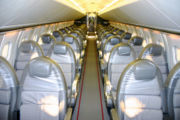
Passenger experience on Concorde differed in many ways from that on subsonic commercial airliners. Air France and British Airways configured the passenger cabin as a single class with 100 seats — four seats across with a central aisle. Headroom in the central aisle was barely six ft (1.8 m) and the leather seats were unusually narrow. The seat pitch was 38-inch (970 mm): giving only about 6 or 7 inches more legroom than in a typical scheduled international Economy class. With little overhead storage, carry-on luggage was severely restricted.
In the 1990s, features which were common in the first class and business class cabins of a long-haul Boeing 747 flight, such as video entertainment, rotating or reclining seats and walking areas were absent from Concorde. However, the flight time from London to New York of approximately 3.5 hrs compensated for the lack of those features. There was usually a plasma display at the front of the cabin showing the altitude, the air temperature and the current speed in both miles per hour and Mach number. (Air France had a single display showing the Mach number-only.)
To make up for these missing "comfort" features, a high level of passenger service was maintained. Passengers were given free champagne and meals were served using compact Wedgwood crockery with short silver cutlery.
The experience of passing through the sound barrier was accompanied by a slight surge in acceleration, and was announced by one of the pilots.
At twice a conventional airliner's cruising altitude, the view from the windows clearly showed the curvature of the Earth, and turbulence was rare. During the supersonic cruise, although the outside air temperature was typically -60 °C (-75 °F), air compression would heat the external skin at the front of the aircraft to approximately +120 °C (250 °F), making the windows warm to the touch and producing a noticeable temperature gradient along the length of the cabin.
The delta-shaped wings allowed Concorde to attain a higher angle of attack than conventional aircraft, as it allowed the formation of large low pressure vortices over the entire upper wing surface, maintaining lift. This low pressure caused Concorde to disappear into a bank of fog on humid days. These vortices formed only at low air speeds, meaning that during the initial climb and throughout the approach Concorde experienced light turbulence and buffeting. Interestingly, the vortex lift created by Concorde's wing just prior to touchdown supplied its own mild turbulence.
Concorde flew fast enough that the weight of everyone onboard was temporarily reduced by about 1% when flying east. This was due to centrifugal effects since the airspeed added to the rotation speed of the Earth. Flying west, the weight increased by about 0.3%, because it cancelled out the normal rotation and, with it, the normal centrifugal force and replaced it with a smaller rotation in the opposite direction. Concorde flew high enough that the weight of everyone onboard was reduced by an additional 0.6% due to the increased distance from the centre of the Earth.
Concorde's cruising speed exceeded the top speed of the solar terminator. Concorde was able to overtake or outrun the spin of the earth. On westbound flights it was possible to arrive at a local time earlier than the flight's departure time. On certain early evening transatlantic flights departing from Heathrow or Paris, it was possible to take off just after sunset and catch up with the sun, landing in daylight. This was much publicised by British Airways, who used the slogan "Arrive before you leave."
Flight characteristics
In regular service, Concorde employed a relatively efficient cruise-climb flight profile. As aircraft lose weight from consuming fuel, they can fly at progressively higher altitudes. This is (generally) more efficient, so conventional airliners employ a stepped climb profile, where air traffic control will approve a change to a higher flight level as the flight progresses. During a landing approach Concorde was on the "back side" of the drag force curve, where raising the nose would increase the sink rate.
With no other civil traffic operating at its cruising altitude of about 56,000 ft (17,000 m), dedicated oceanic airways or "tracks" were used by Concorde to cross the Atlantic. These SST, ("Super-Sonic Transport"), tracks were designated:
- Track Sierra Mike (SM); A uni-directional track used by westbound flights of both Air France and British Airways.
- Track Sierra November (SN); A uni-directional track used by eastbound flights of both Air France and British Airways.
- Track Sierra Oscar (SO); A bi-directional track used by westbound Air France flights which might conflict with westbound British Airways flights routing simultaneously on Track SM, and by eastbound Air France flights which might conflict with eastbound British Airways flights routing simultaneously on Track SN.
- Track Sierra Papa (SP); A uni-directional seasonal track used by westbound British Airways flights routing from London Heathrow to Barbados.
- Track Sierra November (SN); A uni-directional track used by eastbound flights of both Air France and British Airways.
Due to the nature of high altitude winds, these SST tracks were fixed in terms of their co-ordinates, unlike the North Atlantic Tracks at lower altitudes whose co-ordinates alter daily according to forecast weather patterns. Concorde would also be cleared in a 10,000-foot (3,000 m) block, allowing for a slow climb from 50,000 to 60,000 ft (18,000 m) during the oceanic crossing as the fuel load gradually decreased.
BA flights flown by Concorde added "Concorde" in addition to the standard " Speedbird" callsign to notify Air Traffic Control of the aircraft's unique abilities and restrictions. The flight numbers of BA's Concorde flights were 001–004; BA's Concordes therefore used callsigns "Speedbird Concorde 1" through to "Speedbird Concorde 4". With the retirement of Concorde those flight numbers are now unused. French Concordes used the standard "Air France" callsign.
Paris crash
On 25 July 2000, Air France Flight 4590, registration F-BTSC, crashed in Gonesse, France, killing all 100 passengers and nine crew on board the flight, and four people on the ground. It was the only fatal incident involving the type.
According to the official investigation conducted by the French accident investigation bureau (BEA), the crash was caused by a titanium strip, part of a thrust reverser, that fell from a Continental Airlines DC-10 that had taken off about four minutes earlier. This metal fragment punctured a tyre on the left main wheel bogie. The tyre exploded, and a piece of rubber hit the fuel tank and broke an electrical cable. The impact caused a hydrodynamic shockwave that fractured the fuel tank some distance from the point of impact. This caused a major fuel leak from the tank, which then ignited due to severed electrical wires which were sparking. The crew shut down engine number 2 in response to a fire warning but were unable to retract the landing gear, hampering the aircraft's climb. With engine number 1 surging and producing little power, the aircraft was unable to gain height or speed, entering a rapid pitch-up then a violent descent, rolling left. The impact occurred with the stricken aircraft tail-low, crashing into the Hotelissimo Hotel in Gonesse.
Others have disputed the BEA report, citing evidence that the Air France Concorde was overweight, had unbalanced distribution in the fuel tanks, and lacked a critical spacer in the landing gear which caused it to veer. They came to the conclusion that the aircraft veered off course on the runway, which reduced take-off speed below the crucial minimum.
Prior to the accident, Concorde had been arguably the safest operational passenger airliner in the world in terms of passenger deaths-per-kilometres travelled with zero. After the accident, the death rate was 12.5 fatal events per million flights, more than three times worse than the second worst aircraft. However no aircraft's safety can be accurately measured from a single incident and safety improvements were made in the wake of the crash. The crash of the Air France Concorde nonetheless proved to be the beginning of the end for the type.
The accident subsequently led to a programme of modifications, including more secure electrical controls, Kevlar lining to the fuel tanks and specially-developed burst-resistant tyres.
Return to service
The first test flight after the modifications departed from London Heathrow on 17 July 2001, piloted by BA Chief Concorde Pilot Mike Bannister. During the 3:20 hr flight over the mid-Atlantic towards Iceland, Bannister attained Mach 2.02 and 60,000 ft (18,000 m) before returning to RAF Brize Norton. The test flight, intended to resemble the London-New York route, was declared a success and was watched on live TV, and by crowds on the ground at both locations.
The first BA passenger flight took place on 11 September 2001, and was in the air during the September 11, 2001 attacks in the United States. This was not a revenue flight, as all the passengers were BA employees.
Normal commercial operations resumed on 7 November 2001 by BA and AF (aircraft G-BOAE and F-BTSD), with service to New York JFK, where passengers were welcomed by the then-mayor, Rudy Giuliani.
Withdrawal from service

On 10 April 2003, Air France and British Airways simultaneously announced that they would retire Concorde later that year. They cited low passenger numbers following the 25 July 2000 crash, the slump in air travel following 9/11 and rising maintenance costs.
That same day, Sir Richard Branson offered to buy British Airways' Concorde fleet at their "original price of £1" for service with his Virgin Atlantic Airways. Branson claimed this to be the same token price that British Airways had paid the British Government, but BA denied this and refused the offer. The real cost of buying the aircraft was £26 million each but the money for buying the aircraft was loaned by the government, but took 80% of the profits; however BA bought their aircraft for a book value of £1 as part of the £16.5 million buy out in 1983.
Branson wrote in The Economist ( 23 October 2003) that his final offer was "over £5 million" and that he had intended to operate the fleet "for many years to come." Any hope of Concorde remaining in service was further thwarted by Airbus' unwillingness to provide maintenance support for the ageing airframes.
It has been suggested that Concorde was not withdrawn for the reasons usually given, but that during the grounding of Concorde it became apparent to the airlines that they could actually make more revenue carrying their first class passengers subsonically.
Rob Lewis suggested that the precipitous Air France retirement of its own Concorde fleet was the direct result of a secret conspiracy between Air France Chairman/CEO Jean-Cyril Spinetta and then-AIRBUS CEO Noel Forgeard, and stemmed as much from a fear of being found criminally liable under French law for future AF Concorde accidents as it did from simple economics. Further, on the British Airways side, a lack of engineering (maintenance) commitment to Concorde by then-Director of Engineering Alan MacDonald was cited as undermining BA's resolve to continue operating Concorde from within.
Air France
Air France made its final commercial Concorde landing in the United States in New York City from Paris on 30 May 2003. Fire trucks sprayed the traditional arcs of water above F-BTSD on the tarmac of John F. Kennedy airport. The final passenger flight for the airline's SSTs was a charter around the Bay of Biscay. During the following week, on 2 June and 3 June 2003, F-BTSD flew a final round-trip from Paris to New York and back for airline staff and long-time employees in the airline's Concorde operations. Air France's final Concorde flight took place on 27 June 2003 when F-BVFC retired to Toulouse.
An auction of Concorde parts and memorabilia for Air France was held at Christie's in Paris on 15 November 2003. Thirteen hundred people attended, with several lots exceeding their predicted values by an order of magnitude.
After the end-of-service, French Concorde F-BVFC was retired to Toulouse, and kept functional (including engine runs) for a short while, in case taxi runs were required in support of the French judicial enquiry into the 2000 crash. The aircraft is now fully retired and no longer functional. It is open to the public.
French Concorde F-BTSD has been retired to the "Musée de l'Air et de l'Espace" at Le Bourget (near Paris) and, unlike the other museum Concordes, a few of the systems are being kept functional, so that for instance the famous "droop nose" can still be lowered and raised.
This led to rumours that they could be prepared for future flights for special occasions. Without the necessary maintenance organisation, or spares, this is no longer possible.
British Airways
BA's last Concorde departure from Grantley Adams International Airport in Barbados was on 30 August 2003. BA conducted a mini North American farewell tour in October 2003. G-BOAG visited Toronto Pearson International Airport on 1 October 2003, G-BOAD visited Boston's Logan International Airport on 8 October 2003, and G-BOAG visited Washington Dulles International Airport on 14 October 2003. G-BOAD's flight to Boston set a record for the fastest transatlantic flight from east to west, making the trip from London Heathrow in 3 hours, 5 minutes, 34 seconds.
In a final week of farewell flights around the United Kingdom, Concorde visited Birmingham on 20 October, Belfast on 21 October, Manchester on 22 October, Cardiff on 23 October, and Edinburgh on 24 October. Each day the aircraft made a return flight out and back into Heathrow to the cities concerned, often overflying those cities at low altitude. Over 650 competition winners and 350 special guests were carried.
On 22 October, Heathrow ATC arranged for the inbound flight BA9021C, a special from Manchester, and BA002 from New York to land simultaneously on the left and right runways respectively.
On the evening of 23 October 2003, the Queen consented to the illumination of Windsor Castle as Concorde's last west-bound commercial flight departed London and flew overhead. This is an honour normally reserved for major state events and visiting dignitaries.
British Airways retired its aircraft the next day, 24 October. G-BOAG left New York to a fanfare similar to that given for Air France's "F-BTSD", while two more made round trips, G-BOAF over the Bay of Biscay, carrying VIP guests including many former Concorde pilots, and G-BOAE to Edinburgh. The three aircraft then circled over London, having received special permission to fly at low altitude, before landing in sequence at Heathrow. The two round-trip aircraft landed at 4:01 and 4:03 p.m. BST, followed at 4:05 by the one from New York. All three aircraft then spent 45 minutes taxiing around the airport before finally disembarking the last supersonic fare-paying passengers. The captain of the New York to London flight was Mike Bannister.
All of BA's Concorde fleet have been grounded, have lost their airworthiness certificates and have been drained of hydraulic fluid. Ex-chief Concorde pilot and manager of the fleet Jock Lowe, estimated in 2004 it would cost £10-15 million to make G-BOAF (at Filton) airworthy again.. BA maintains ownership of their fleet, and has stated that they will never fly again, as Airbus will not support the aircraft.
On 1 December 2003, Bonhams held an auction of British Airways' Concorde artifacts at Kensington Olympia, in London. Items sold included a Machmeter, nose cone, pilot and passenger seats, cutlery, ashtrays and blankets used on board. Proceeds of about £750,000 resulted, with the first half-million going to Get Kids Going!, a charity which gives disabled children and young people the opportunity to participate in sport.
BA announced in March 2007 that they would not be renewing their contract for the prime advertising spot at entrance to London's Heathrow Airport, where, since 1990, a 40% scale model of Concorde was located. The owners of the site, BAA wanted to charge £1.6 million per year to let it. It will now be occupied by an Emirates Airbus A380. The Concorde model, which bears the "registration" G-CONC, was removed and transported for display in Surrey, under the care of the local Brooklands Museum.
Aircraft histories
In total, 20 Concordes were built, six for development and 14 for commercial service.
These were:
- Two prototypes
- Two pre-production aircraft
- 16 production aircraft
- The first two of these did not enter commercial service
- Of the 14 that flew commercially, 8 were still in service in April 2003
All but two of these aircraft, a remarkably high percentage for any commercial fleet, are preserved; the two that are not preserved are F-BVFD (cn 211), parked as a spare-parts source in 1982 and scrapped in 1994, and F-BTSC (cn 203), which crashed in Paris on 25 July 2000.
| Number | Reg | First flew | Last flew | Hours | Location |
|---|---|---|---|---|---|
| 001 | F-WTSS | 2 March 1969 | 19 October 1973 | 812 | The Museum of Air and Space, Le Bourget, France |
| 002 | G-BSST | 9 April 1969 | 4 March 1976 | 836 | Fleet Air Arm Museum, Yeovilton, England, UK |
| 101 | G-AXDN | 17 December 1971 | 20 August 1977 | 632 | Imperial War Museum, Duxford, England, UK |
| 102 | F-WTSA | 10 January 1973 | 20 May 1976 | 656 | Musée Delta, Orly Airport, Paris, France |
| 201 | F-WTSB | 6 December 1973 | 19 April 1985 | 909 | Airbus Factory, Toulouse, France |
| 202 | G-BBDG | 13 December 1974 | 24 December 1981 | 1282 | Brooklands Museum, Weybridge, Surrey, England, UK |
| 203 | F-BTSC | 31 January 1975 | 25 July 2000 | 11989 | Destroyed in air crash outside Paris, France |
| 204 | G-BOAC | 27 February 1975 | 31 October 2003 | 22260 | Manchester Airport Viewing Park, England, UK. This aircraft was British Airways' flagship Concorde, due to its BOAC registration as it was the first Concorde delivered to BA. |
| 205 | F-BVFA | 27 October 1976 | 12 June 2003 | 17824 | Steven F. Udvar-Hazy Centre of the Smithsonian National Air and Space Museum, Chantilly, Virginia USA (near Washington, DC) |
| 206 | G-BOAA | 5 November 1975 | 12 August 2000 | 22768 | Museum of Flight, East Lothian, Scotland, UK |
| 207 | F-BVFB | 6 March 1976 | 24 June 2003 | 14771 | Sinsheim Auto & Technik Museum, Germany |
| 208 | G-BOAB | 18 May 1976 | 15 August 2000 | 22296 | Heathrow Airport, London, England, UK |
| 209 | F-BVFC | 9 July 1976 | 27 June 2003 | 14332 | Airbus Factory, Toulouse, France |
| 210 | G-BOAD | 25 August 1976 | 10 November 2003 | 23397 | Intrepid Sea-Air-Space Museum, New York, USA; in December 2006, the aircraft was temporarily moved to Floyd Bennett Field in Brooklyn for the duration of restoration and rehabilitation work on Intrepid and the pier at which Intrepid and Concorde were located, expected to last until 2008 |
| 211 | F-BVFD | 10 February 1977 | 27 May 1982 | 5814 | Spare-parts source after 1982 and scrapped in 1994 |
| 212 | G-BOAE | 17 March 1977 | 17 November 2003 | 23376 | Grantley Adams International Airport, Barbados |
| 213 | F-BTSD | 26 June 1978 | 14 June 2003 | 12974 | The Museum of Air and Space, Le Bourget, France |
| 214 | G-BOAG | 21 April 1978 | 5 November 2003 | 16239 | Museum of Flight, Seattle, USA |
| 215 | F-BVFF | 26 December 1978 | 11 June 2000 | 12421 | Charles de Gaulle Airport, Paris, France |
| 216 | G-BOAF | 20 April 1979 | 26 November 2003 | 18257 | Filton Aerodrome, Bristol, England, UK |
- In addition, some spare parts, including Rolls-Royce Olympus engines and Snecma intakes are in the Museo del Concorde in Ciudad Juárez, Chihuahua, Mexico. This museum was relocated and opened to the public on May 6, 2008.
Restoration
Along with a dedicated group of French volunteer engineers keeping one of the youngest Concordes (F-BTSD) in near-airworthy condition at the Le Bourget Air and Space Museum in Paris, a UK society, Club Concorde, has launched a campaign to get an aircraft flying by 2010.
Although only a "static" example, Concorde G-BBDG was restored from essentially a shell at the Brooklands Museum in Surrey.
Environmental impact
People's reaction to the prospect of severe overhead noise represented a significant change socially. Prior to Concorde's flight trials, the developments made by the civil aviation industry were largely accepted by governments and their respective electorates. However, the opposition to Concorde's noise, particularly on the eastern coast of the United States, forged a new political agenda on both sides of the Atlantic, with scientists and technology experts across a multitude of industries beginning to take the environmental and social impact more seriously. Although Concorde led directly to the introduction of a general noise abatement programme for aircraft flying out of John F Kennedy Airport, it was later found that Concorde was actually quieter than some aircraft, partly due to the pilots temporarily throttling back their engines to reduce noise during overflight of residential areas.
Concorde produced nitrogen oxides in its exhaust, which, despite complicated chemical interactions with other ozone-depleting chemicals, are understood to produce a net degradation to the ozone layer at the stratospheric altitudes it cruised. It has been pointed out that other, lower-flying, airliners produce ozone during their flights in the troposphere, but vertical transit of gases between the two is highly restricted. The small fleet size meant that any net ozone-layer degradation caused by Concorde was for all practical purposes negligible.
From this perspective, Concorde's technical leap forward can be viewed as boosting the public's (and the media's) understanding of conflicts between technology and the environment. In France, the use of acoustic fencing alongside TGV tracks might not have been achieved without the 1970s furore over aircraft noise. In Britain, the CPRE have issued tranquility maps since 1990 and public agencies are starting to do likewise.
Concorde travelled, per passenger, 17 miles (27 km) for each gallon of fuel (mpg) (or 20 l/100 km). This efficiency is comparable to a Gulfstream G550 business jet (~16 mpg or 18 l/100 km per passenger), but much lower than a Boeing 747-400 (~91 mpg or 3.1 l/100 km per passenger).
Public perception
Concorde was normally perceived as a privilege of the rich, but special circular or one-way (with return by coach or ship) charter flights were arranged to bring a trip within the means of moderately well-off enthusiasts.
The presence of a Concorde flying overhead would frequently temporarily halt day-to-day business as people would stop to watch as the plane flew overhead. A noteworthy example can be found in the TV programme Scrapheap Challenge, where the mechanics drop all their tools and wave as Concorde flies over the yard.
The aircraft was usually referred to by the British as simply "Concorde", whilst in France it was known as "le Concorde" due to "le", the definite article, being used in French grammar to distinguish a proper name from a common noun of the same spelling. In French, the common noun concorde means "agreement, harmony, or peace" and the aircraft's name was almost certainly chosen for its allusion to the collaboration between the British and French governments. Concorde's pilots and British Airways in official publications and videos often refer to Concorde both in the singular and plural as "she" or "her."
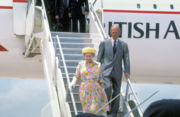
Concorde remains a powerful symbol, both for its technology and sculptural shape. It is a symbol of great national pride to many in Britain and France; in France it was thought of as a French aircraft, in Britain as British.
As a symbol of national pride, an example from the BA fleet made occasional flypasts at selected Royal events, major air shows and other special occasions, sometimes in formation with the Red Arrows. On the final day of commercial service, public interest was so great that grandstands were erected at London's Heathrow Airport to afford a view of the final arrivals. Crowds filled the boundary road around the airport and there was extensive media coverage.
Thirty-seven years after her first test flight, Concorde was announced the winner of the Great British Design Quest, organised by the BBC and the Design Museum. A total of 212,000 votes were cast with Concorde beating design icons such as the Mini, mini skirt, Jaguar E-type, Tube map and the Supermarine Spitfire.
Comparison with other supersonic aircraft
The only other supersonic airliner in direct competition with Concorde was the Soviet Tu-144. Although the Tu-144 entered service earlier, it was retired in 1978. Although Lockheed, North American Aviation and Boeing prepared supersonic airliner studies, only the still-born project, the Boeing 2707, proceeded to the mock-up stage as the sole American entry into the supersonic sweepstakes.
As a result of a rushed development programme, the Tu-144 was cruder and less refined than Concorde, with cabin noise notably higher. The Tu-144S had significantly lower range than Concorde, largely due to its low-bypass turbofan engines. It required reheat to maintain Mach 2.0 and cruised at Mach 1.6. The vehicle had poor control at low speeds because of a simpler, dedicated supersonic wing design. In addition, the Tu-144 required parachutes to land while Concorde had sophisticated anti-lock brakes. It also had two crashes, one at the 1973 Paris Air Show, which made further sales impossible, and another during a pre-delivery test flight. Later versions had retractable canards for better low speed control, and used turbojet engines that gave them nearly the fuel efficiency and similar range to Concorde. It had 126 seats. With a top speed of Mach 2.35 (made possible due to titanium and steel leading edges) and a cruise of Mach 2.16 it was potentially a more competitive aircraft, but it did not sell.
The American design was to have been larger, seating 300. It was also intended to reach higher speeds of up to Mach 3.0, which made the construction more difficult, as high temperatures ruled out the use of duralumin with design calculations that showed that the extra speed would have only cut Concorde's transatlantic travel by 20 minutes. Running a few years behind Concorde, the extra costs of these features may have helped to kill the project. The discovery from flights of the XB-70 Valkyrie that sonic booms were quite capable of reaching the ground and the experience from the Oklahoma City sonic boom tests debacle led to the same environmental concerns that contributed to hindering commercial success of Concorde. The American government cancelled the project in 1971, after having spent more than $1 billion.
Possible replacements
In November 2003, EADS, parent company of the Airbus aircraft manufacturing company, announced that it was considering working with Japanese companies to develop a larger, faster replacement for Concorde. However, recent news reports suggest only $1m is being invested every year into research, much less than the $1bn needed for the development of a viable supersonic airliner.
In October 2005, JAXA, the Japan Aerospace eXploration Agency, undertook aerodynamic testing of a scale model of an airliner designed to carry 300 passengers at Mach 2. If pursued to commercial deployment, it would be expected to be in service around 2020 - 2025.
The British company Reaction Engines Limited, with 50% EU money, are engaged in a research programme called LAPCAT, which is examining a design for a hydrogen-fuelled plane carrying 300 passengers called the A2, capable of flying nonstop from Brussels to Sydney at Mach 5+ in 4.6 hours.
In May 2008, it was reported that Aerion had $3 billion of preorder sales on its supersonic business jet.
Research into supersonic business jets continues.
Operators
- Air France
Specifications
General characteristics
- Crew: 3 (pilot, co -pilot and flight engineer)
- Capacity: 92-120 passengers (128 in high-density layout). BA and AF Concordes had 100 seats. with AF removing a small number of seats after the safety modifications of CY2000-2001 due to weight considerations.
- Length: 202 ft 4 in (61.66 m)
- Wingspan: 84 ft 0 in (25.6 m)
- Height: 40 ft 0 in (12.2 m)
- Fuselage internal length: 129 ft 0 in (39.32 m)
- Fuselage max external width: 9 ft 5 in (2.88 m)
- Fuselage max internal width: 8 ft 7 in (2.63 m)
- Fuselage max external height: 10 ft 10 in (3.32 m)
- Fuselage max internal height: 6 ft 5 in (1.96 m))
- Wing area: 3,856 ft² (358.25 m²)
- Empty weight: 173,500 lb (78,700 kg)
- Useful load: 245,000 lb (111,130 kg)
- Powerplant: 4× Rolls-Royce/ SNECMA Olympus 593 Mk 610 afterburning turbojets
- Dry thrust: 32,000 lbf (140 kN) each
- Thrust with afterburner: 38,050 lbf (169 kN) each
- Maximum fuel load: 210,940 lb (95,680 kg)
- Maximum taxiing weight: 412,000 lb (186,880 kg)
Performance
- Maximum speed: Mach 2.2 (~1,450 mph, 2,330 km/h)
- Cruise speed: Mach 2.02 (~1,320 mph)
- Range: 3,900 nmi (4,500 mi, 7,250 km)
- Service ceiling 60,000 ft (18,300 m)
- Rate of climb: 5,000 ft/min. (25.41 m/s)
- Thrust/weight: 0.373
- Lift/drag ratio: Low speed- 3.94, Approach- 4.35, 250 kn, 10,000 ft- 9.27, Mach 0.94- 11.47, Mach 2.04- 7.14
- Fuel consumption for max. range (max. fuel/max. range): 46.85 lb/ mi (13.2 kg/km)
- Maximum nose tip temperature: 260 °F (127 °C)
Popular culture
Concorde has numerous appearances in various media. Particularly notable or extended appearances or mentions include:
- The Concorde: Airport '79 film: Concorde starred in this film sequel in the Airport series. The Concorde used for the live-action aerial filming was the Air France Concorde that crashed 21 years later on 25 July 2000.
- The Concorde Affair (Concorde Affaire in orig.) Italy (1979) film: Director: Ruggero Deodato.
- Time-Flight, a serial of the science fiction programme Doctor Who, revolves around the mysterious disappearance of two Concorde flights.
- There is a chapter dedicated to Concorde in Jeremy Clarkson's book, I Know You Got Soul.
